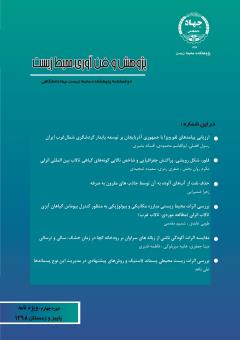بررسی اثرات زیست محیطی پسماند لاستیک و روشهای پیشنهادی در مدیریت این نوع پسماندها
محورهای موضوعی :
1 - دانشگاه گیلان
کلید واژه: پسماند لاستیک, مدیریت پسماند, پیرولیز, آسیاب , آلودگی زیستمحیطی,
چکیده مقاله :
لاستیک از جمله موادی است که کاربرد وسیعی در صنعت دارد و زمانیکه عمر مصرفی آنها به پایان میرسد در رده مواد زائد خطرناک قرار میگیرند. رهاسازی پسماندهای لاستیک در محیط زیست سبب ایجاد مشکلات زیادی اعم از بیماریها، منظره بد آنها در طبیعت و آتشسوزیهای مهیب ناشی از انباشتگی آنها و آلودگیهای زیستمحیطی میشود. همچنین لاستیک به علت عدم تخریب پذیری و داشتن خاصیت الاستیکی، قابلیت استفاده مجدد را دارا میباشد. در نتیجه مدیریت لاستیکهای فرسوده از اهمیت ویژهای برخوردار میگردد. روشهای متعددی برای مدیریت پسماند لاستیک وجود دارد که وقتی به درستی اجرا شود میتواند امن و موثر باشد. این روشها عبارتند از: دفن بهداشتی، سوزاندن برای تولید انرژی، پیرولیز، آسیاب کردن، استفاده مجدد در مقیاس مختلف و روکش مجدد است. در این مقاله، به بررسی هر یک از روشها پرداخته و معایب و مزایای آنها بیان شده است. همچنین مواردی از کاربردهای مختلف پسماند لاستیک در صنایع گوناگون آورده شده است.
Rubber is one of the materials that are widely used in industry and when they expire, they fall into the category of hazardous wastes. The release of rubber wastes into the environment causes many problems, including diseases, their bad landscape in nature, and terrible fires caused by their accumulation and environmental pollution. Also, rubber can be reused due to its non-degradability and elastic properties; as a result, the management of worn tires has a particular importance. There are several ways to manage rubber waste that can be safe and effective when done properly. These methods include sanitary landfilling, incineration, pyrolysis, milling, reuse at various scales, and re-coating. In this article, each method is reviewed and their advantages and disadvantages are stated. Also, there are examples of different applications of rubber waste in various industries.
1. Betancur, M., Martínez, J. D., & Murillo, R., Journal of hazardous materials, 168(2), 882-887. (2009).
2. California waste tire generation, markets, and disposal. CIWMB staff report (2006).
3. Karthikeyan, S., Sathiskuman, C., Srinivasa Moorthy, R., Journal of Scientific & Industrial Research, 71(5), 309-315 (2012).
4. Oyedun, A., Lam, K. L., Fittkau, M., Hui, C. W., Fuel, 95, 417-424 (2012).
5. حسینی، سید محمد؛ بهمن پور، هومن؛ مدیریت لاستیکهای فرسوده، اولین همایش بین المللی و سومین همایش ملی مهندسی و مدیریت کشاورزی محیط زیست و منابع طبیعی پایدار، 10 اسفند 1394.
6. باطنی، فاطمه؛ مکی، تکتم؛ موسوی، طاهره؛ مروری بر کاربردهای لاستیک فرسوده. دومین کنفرانس برنامه ریزی و مدیریت محیط زیست، ۱۳۹۱.
7. عباسی دزفولی, عبدالکریم؛ منابی، رضا؛ سلیمانی ورپشتی، علی؛ بررسی روند تولید واستفاده از خرده لاستیکهای فرسوده دربتن،آسفالت و قطعات بتنی، اولین کنفرانس ملی عمران و توسعه، ۱۳۹۰.
8. Sadaka, F. Campistron, A. Laguerre, J. Pilard, F. Polymer degradation and stability, 97, 816-828 (2012).
9. California waste tire Generation, Markets, and Disposal. 33, 235-265 (2001).
10. Siddique, R. Naik, T. Waste management, 24, 563-569 (2004).
11. Pawan R. Shakya a, Pratima Shrestha. Atmospheric Environment. 42, 6555-6559 (2008).
12. Fiksel, J., Bakshim B.R., Baral, A., Guerra, E., DeQuervain, B., Clean Technol Environ Policy 13, 19–35 (2011).
13. EPA-Scrap Tires Common Wastes & Materials. Retrieved November 12, (2012). from http://www.epa.gov/osw/conserve/materials/tires/index.htm
14. Nokyoo, C., Ph.D. Thailand Policy and Strategy for Waste Management: Waste & Hazardous Substances Management, Bureau of Pollution Control Department, Thailand (2010).
15. EPA-Tire Fires (2012). Retrieved December 3 (2012), from
16. http://www.epa.gov/osw/conserve/materials/tires/fires.htm
17. Reisman, J., & Lemieux, P. (1997). Air Emissions from Scrap Tire Combustion. US Environmental Protection Agency. Retrieved November 27, 2012, from http://www.epa.gov/ttncatc1/dir1/tire_eng.pdf
18. Morris, J. Journal of Hazardous Materials, 47(1-3), 277-293 (1996).
19. Tire Recycling Industry: A Global View. (2003). (http://www.irevna.com/pdf/Industry%20report.pdf)
20. Rombaldo, C. F. S., Lisbôa, A. C. L., Méndez, M. O. A., & Coutinho, A. D. R., Materials Research, 11(3), 359-363 (2008).
21. Wójtowicz, M. A., & Serio, M. A. Pyrolysis of scrap tires: Can it be profitable?. CHEMTECH-WASHINGTON DC-, 26, 48-53 (1996)
22. Reschner, K. Scrap Tire Recycling - A Summary of Prevalent Disposal and Recycling Methods (2008).
23. Roy C., Labrecque B. & Caumia B., Resources, conservation and recycling, 4, 203-213 (1990). 75
24. Sienkiewicz, M., Kucinska-Lipka, J., Janik, H., & Balas, A. Waste Management, 32(10), 1742-1751 (2012).
25. Tire Recycling Made Simple. Retrieved December 15 (2012), from http://www.scraptirenews.com/crumb.php
26. بخشنده، غ؛ احسانی، م؛ کاووسی، ک؛ مجله صنعت لاستیک ایران. سال يازدهم، شماره 42، ، 94-100، آبان 1385.


